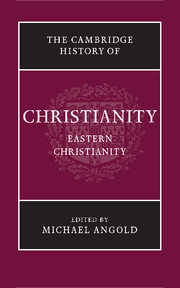Book contents
- Frontmatter
- PART I THE ECUMENICAL PATRIARCHATE
- PART II THE RUSSIAN CHURCH
- PART III EASTERN CHRISTIANITIES
- 16 Eastern Christianities (eleventh to fourteenth century): Copts, Melkites, Nestorians and Jacobites
- 17 The Armenians in the era of the crusades 1050–1350
- 18 Church and diaspora: the case of the Armenians
- 19 Church and nation: the Ethiopian Orthodox Täwahedo Church (from the thirteenth to the twentieth century)
- 20 Coptic Christianity in modern Egypt
- 21 Syriac Christianity in the modern Middle East
- PART IV THE MODERN WORLD
- Bibliography
- Index
- References
21 - Syriac Christianity in the modern Middle East
from PART III - EASTERN CHRISTIANITIES
Published online by Cambridge University Press: 28 March 2008
- Frontmatter
- PART I THE ECUMENICAL PATRIARCHATE
- PART II THE RUSSIAN CHURCH
- PART III EASTERN CHRISTIANITIES
- 16 Eastern Christianities (eleventh to fourteenth century): Copts, Melkites, Nestorians and Jacobites
- 17 The Armenians in the era of the crusades 1050–1350
- 18 Church and diaspora: the case of the Armenians
- 19 Church and nation: the Ethiopian Orthodox Täwahedo Church (from the thirteenth to the twentieth century)
- 20 Coptic Christianity in modern Egypt
- 21 Syriac Christianity in the modern Middle East
- PART IV THE MODERN WORLD
- Bibliography
- Index
- References
Summary
The term Syriac Christianity refers to the various Middle Eastern and Indian churches which belong to the Syriac tradition. Since late antiquity they have divided liturgically and doctrinally into three main groups: the Syrian Orthodox Church sometimes known erroneonsly as the Jacobite Church, which has rejected the doctrinal definition of the council of Chalcedon (451) and insists on the oneness of humanity and divinity in the incarnate Christ; the Church of the East, sometimes known wrongly as the Nestorian or Assyrian Church, which has on different grounds rejected the council of Chalcedon, essentially because it did not distinguish strictly enough between the two natures in Christ; and finally the Maronites of the Lebanon, who have come to accept the definitions of Chalcedon. Cutting across this scheme has been the creation of eastern rite Catholic churches. The term ‘Syrian’ used here to designate individual churches is thus much broader than the geographical area of modern Syria. There have long been Syrian churches in India, but they now spread over all five continents, with sizeable diaspora communities in western Europe, the Caucasian states, North and South America and Australasia.
The Syrian Orthodox Church
From the seventeenth century onwards the history of the Syrian Orthodox Church has seen a struggle between a romanising party and one opposed to all union. For most of the nineteenth century the anti-unionists were in the ascendant, but at the turn of the century there was a shift towards Rome. The bitterness of these disputes was soon overshadowed by the catastrophe which overtook the Syrian churches in the declining years of the Ottoman Empire.
- Type
- Chapter
- Information
- The Cambridge History of Christianity , pp. 511 - 536Publisher: Cambridge University PressPrint publication year: 2006
References
- 2
- Cited by

